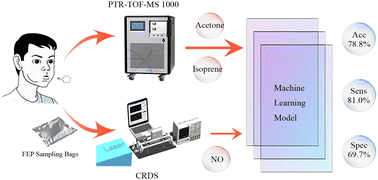A combined screening study for evaluating the potential of exhaled acetone, isoprene, and nitric oxide as biomarkers of lung cancer
Abstract
Background: the early lung cancer (LC) screening strategy significantly reduces LC mortality. According to previous studies, lung cancer can be effectively diagnosed by analyzing the concentration of volatile organic compounds (VOCs) in human exhaled breath and establishing a diagnosis model based on the different VOCs. This method, called breath analysis, has the advantage of being rapid and non-invasive. To develop a non-invasive, portable breath detection instrument based on cavity ring-down spectroscopy (CRDS), we explored the feasibility of establishing a model with acetone, isoprene, and nitric oxide (NO) exhaled through human breath, which can be detected on the CRDS instrument. Methods: a total of 511 participants were recruited from the Cancer Institute and Hospital, Tianjin Medical University as the discovery set and randomly split (2 : 1) into training set and internal validation set with stratification. For external validation, 51 participants were recruited from the General Hospital, Tianjin Medical University. Acetone and isoprene from exhaled breath were detected by proton-transfer-reaction time-of-flight mass spectrometry (PTR-TOF-MS), and NO was measured using CRDS. The model was constructed using the ensemble learning method that set eXtreme gradient boosting and logistic regression as the basis model and logistic regression as the senior model. The model was evaluated based on accuracy, sensitivity, and specificity. Results: the model achieved an accuracy of 78.8%, sensitivity of 81.0%, specificity of 70.0%, and area under the receiver operating curve (ROC, AUC) of 0.8341 (95% CI from 0.8055 to 0.8852) in the internal validation set. Furthermore, it attained an accuracy of 66.7%, sensitivity of 68.2%, specificity of 65.5%, and AUC of 0.6834 (95% CI from 0.5259 to 0.7956) in the external validation set. Conclusion: the model, established with acetone, isoprene, and NO as predictors, possesses the ability to identify LC patients from healthy control (HC) participants. The CRDS instrument, which simultaneously detects acetone, isoprene, and NO, is expected to be a non-invasive, rapid, portable, and accurate device for early screening of LC.



 Please wait while we load your content...
Please wait while we load your content...